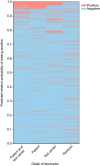Smart pooling: AI-powered COVID-19 informative group testing
- PMID: 35444162
- PMCID: PMC9020431
- DOI: 10.1038/s41598-022-10128-9
Smart pooling: AI-powered COVID-19 informative group testing
Abstract
Massive molecular testing for COVID-19 has been pointed out as fundamental to moderate the spread of the pandemic. Pooling methods can enhance testing efficiency, but they are viable only at low incidences of the disease. We propose Smart Pooling, a machine learning method that uses clinical and sociodemographic data from patients to increase the efficiency of informed Dorfman testing for COVID-19 by arranging samples into all-negative pools. To do this, we ran an automated method to train numerous machine learning models on a retrospective dataset from more than 8000 patients tested for SARS-CoV-2 from April to July 2020 in Bogotá, Colombia. We estimated the efficiency gains of using the predictor to support Dorfman testing by simulating the outcome of tests. We also computed the attainable efficiency gains of non-adaptive pooling schemes mathematically. Moreover, we measured the false-negative error rates in detecting the ORF1ab and N genes of the virus in RT-qPCR dilutions. Finally, we presented the efficiency gains of using our proposed pooling scheme on proof-of-concept pooled tests. We believe Smart Pooling will be efficient for optimizing massive testing of SARS-CoV-2.
© 2022. The Author(s).
Conflict of interest statement
The authors declare no competing interests.
Figures





Similar articles
-
Test Groups, Not Individuals: A Review of the Pooling Approaches for SARS-CoV-2 Diagnosis.Diagnostics (Basel). 2021 Jan 4;11(1):68. doi: 10.3390/diagnostics11010068. Diagnostics (Basel). 2021. PMID: 33406644 Free PMC article. Review.
-
Comparing two sample pooling strategies for SARS-CoV-2 RNA detection for efficient screening of COVID-19.J Med Virol. 2021 May;93(5):2805-2809. doi: 10.1002/jmv.26632. Epub 2021 Mar 11. J Med Virol. 2021. PMID: 33107614
-
Assessing the dilution effect of specimen pooling on the sensitivity of SARS-CoV-2 PCR tests.J Med Virol. 2021 Mar;93(3):1568-1572. doi: 10.1002/jmv.26519. Epub 2020 Sep 30. J Med Virol. 2021. PMID: 32936471
-
Evaluation of sample pooling for screening of SARS CoV-2.PLoS One. 2021 Feb 26;16(2):e0247767. doi: 10.1371/journal.pone.0247767. eCollection 2021. PLoS One. 2021. PMID: 33635923 Free PMC article.
-
Sample pooling strategies for SARS-CoV-2 detection.J Virol Methods. 2021 Mar;289:114044. doi: 10.1016/j.jviromet.2020.114044. Epub 2020 Dec 11. J Virol Methods. 2021. PMID: 33316285 Free PMC article. Review.
Cited by
-
A Novel Bayesian Optimization-Based Machine Learning Framework for COVID-19 Detection From Inpatient Facility Data.IEEE Access. 2021 Jan 11;9:10263-10281. doi: 10.1109/ACCESS.2021.3050852. eCollection 2021. IEEE Access. 2021. PMID: 34786301 Free PMC article.
-
Considerations for Pooled Testing of Employees for SARS-CoV-2.J Occup Environ Med. 2021 Jan 1;63(1):1-9. doi: 10.1097/JOM.0000000000002049. J Occup Environ Med. 2021. PMID: 33378322 Free PMC article.
-
Test Groups, Not Individuals: A Review of the Pooling Approaches for SARS-CoV-2 Diagnosis.Diagnostics (Basel). 2021 Jan 4;11(1):68. doi: 10.3390/diagnostics11010068. Diagnostics (Basel). 2021. PMID: 33406644 Free PMC article. Review.
-
Adaptive group testing strategy for infectious diseases using social contact graph partitions.Sci Rep. 2023 Jul 26;13(1):12102. doi: 10.1038/s41598-023-39326-9. Sci Rep. 2023. PMID: 37495642 Free PMC article.
-
Sample pooling: burden or solution?Clin Microbiol Infect. 2021 Sep;27(9):1212-1220. doi: 10.1016/j.cmi.2021.04.007. Epub 2021 Apr 18. Clin Microbiol Infect. 2021. PMID: 33878507 Free PMC article. Review.
References
-
- World Health Organization. Coronavirus disease 2019 (covid-19): Situation report, 72. World Health Organization (2020).
-
- Max Roser, E. O.-O., Ritchie, H. & Hasell, J. Coronavirus pandemic (covid-19). Our World in Data. https://ourworldindata.org/coronavirus (2020).
Publication types
MeSH terms
Substances
LinkOut - more resources
Full Text Sources
Medical
Miscellaneous

